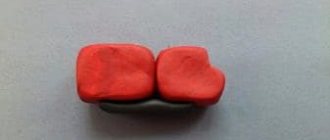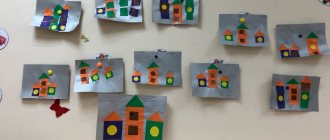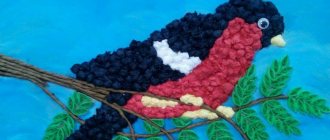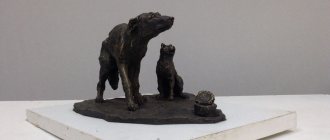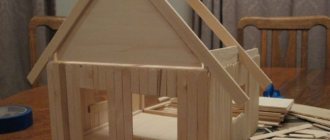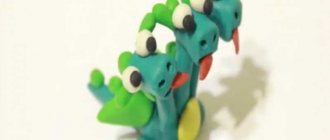Middle group. Junior preschool age. Children 4 - 5 years old
Summary of a modeling lesson in the middle group “Sonyushki-Pelenashki” Goal: to instill in children a love of folk art through artistic and aesthetic development. Objectives: teach children to create original compositions in matchboxes, sculpt swaddle dolls in cradles. Introduce the type of folk doll - diaper, explain the meaning...
Summary of a modeling lesson in the middle group “Jolly Snowmen” Summary of organized educational activities Educational area: “Artistic and aesthetic development”
Section:
“
Modeling ” Topic:
“Funny Snowmen”
Age group: average Purpose: Increasing children’s interest in making a snowman from plasticine. Tasks:…
Long-term plan for modeling in the middle group
Anastasia Mirsaidova
Long-term plan for modeling in the middle group
PERSPECTIVE PLAN FOR MODELING MIDDLE GROUP
T. S. Komarova “Classes in visual arts in the middle group”
I. A. Lykova “Art activities in kindergarten. Middle group"
G. S. Shvaiko “Fine art classes in kindergarten. Middle group"
D. N. Koldina “ Modeling with children 4-5 years old”
SEPTEMBER
1 object “Eared pyramids” Learn to sculpt pyramids from disks of different sizes with the top of an animal. Show planning of Lykov’s work “Art activities in kindergarten. Middle group” , p. 28
2 Modeling from plasticine “Basket with berries” Learn to sculpt a hollow object with a handle. Continue to teach how to roll small balls between Koldin’s palms, “ Modeling with children 4-5 years old ,” p. 13
3 Modeling “Cucumber beets” Introduce the techniques of sculpting oval shapes . Learn to convey the features of each subject Komarov “Classes in visual activities in the middle group” , p. thirty
4 Modeling from plasticine “Pie” Continue to sculpt round objects, flattening the ball between the palms, decorate Koldin’s products, p. 19
OCTOBER
1 Modeling “Big and small carrots” Learn to sculpt elongated objects. fasten sculpt large and small objects Komarov, p. 28
2 Modeling “Mushrooms” Strengthen the ability to sculpt familiar objects, using familiar techniques to clarify the shape of Komarov, p. 36
3 Modeling “Plums and Lemons” Strengthen the ability to sculpt oval-shaped objects Komarov, p. 43
4 Plasticineography “Leaves are flying in the wind” Reinforce the ability to apply plasticine in a thin layer on cardboard
NOVEMBER
1 Modeling from plasticine “Snail” Continue rolling out a column from the ball and rolling it into a spiral, pulling and rounding the ends Koldin, p. 42
2 Modeling – plot “Here is a hedgehog - neither head nor legs...” Learn to sculpt a hedgehog, conveying the characteristic features of its appearance, experiment with art materials when creating a prickly “fur coat” Lykov, p. 52
3 Modeling of the Dymkovo toy “Duck” Introduce the toys, draw attention to the streamlined shape, painting by Komarov, p. 47
4 Modeling based on the Hungarian fairy tale “Two Greedy Little Bears” Learn to sculpt bear cubs in a constructive way (in pairs)
Lykova, s. 84
DECEMBER
1 By design To consolidate previously learned techniques in sculpting familiar objects
2 Modeling “Fish” Reinforce the techniques of pulling and flattening while conveying the characteristic features of a fish, learn to designate Komarov’s scales with a stack, p. 40
3 Modeling “Girl in a Fur Coat” Learn to highlight parts of the human figure in clothes, convey them in compliance with the proportions of Komarov, p. 51
4 Modeling from plasticine “Green Christmas tree” Learn to convey the structure of a Christmas tree by connecting columns of different lengths in a certain sequence Koldina, p. 25
JANUARY
1 Vacation
2 Modeling the plot “The Snow Maiden is dancing” Learn to sculpt the Snow Maiden in a long fur coat in a rational way - from a cone, position it vertically, giving stability. Show techniques for conveying movement by Lykov, p. 68
3 Modeling “Cup and Saucer” Continue sculpting the ball by pressing your thumb into it, aligning the edges with your fingers. Roll out the column and attach. Strengthen the ability to roll a ball and flatten it Koldin, p. 18
4 Modeling from plasticine “Pyramid” Strengthen the ability to roll balls of different sizes and flatten them between the palms, arrange the resulting circles in a certain order Koldina, p. 41
FEBRUARY
1 Introduction to small-form sculpture Introduce a new type of fine art - small-form sculpture. Learn to understand the content of sculpture and its means . Give an idea that sculpture is made from various materials Shvaiko “Fine art classes in kindergarten. Middle group” , p. 76
2 Modeling from plasticine “Airplanes” Continue rolling out the columns on the cardboard with forward and backward movements and connecting them. Practice working with the Koldin stack, p. 32
3 Modeling (collective)
“Birds at the feeder” Learn to convey a simple pose. Learn to combine your work with your friends. Komarova, s. 65
4 Modeling with additional with the material “Boat” Continue to teach how to roll out an oval from a ball, flatten it and press the middle with your fingers, tighten and trim the edges. Learn to complement the image with details Koldin, p. 22
MARCH
1 Modeling from plasticine “Family of nesting dolls” Learn to sculpt an oval-shaped object using a plastic method, pressing the craft from below for stability. Continue to introduce the smoothing technique. Strengthen the ability to decorate a product with bas-relief Koldin, p. 33
2 Modeling (collective)
“Duck with ducklings” Continue to introduce Dymkovo toys. Learn to sculpt figures on a stand, conveying the difference in size Komarov, p. 52
3 Plasticineography “Flower - seven-flowered” Reinforce the ability to apply plasticine in a thin layer on cardboard Koldin, p. 35
4 Modeling “Little Goat” Learn to sculpt a four-legged animal. Reinforce Komarov's sculpting , p. 73
APRIL
1 Round Dance” Learn to depict a human figure, correctly representing the advanced ratio of parts with the size of Komarov, p. 63
2 Modeling “A bird pecks grains on a saucer” Strengthen the ability to sculpt familiar objects, using Komarov’s previously learned techniques, p. 82
3 Modeling “Bowl” Learn to sculpt with familiar techniques and new ones - pressing and pulling, leveling them with Komarov’s fingers, p. 70
4 Modeling “Lamb” Introduce Filimonov toys. Create a desire to make a Komarov toy, p. 78
MAY
1 Plasticineography “Spring Rain” Reinforce the ability to apply plasticine in a thin layer on cardboard, complementing the drawing
2 Plasticine molding “Teremok” Learn to divide the columns and lay out the desired image on them in the form of a bas-relief. Strengthen the ability to work with the Koldin stack, p. thirty
3 Modeling from plasticine using natural material “Swan on the Lake” Strengthen the ability to combine natural material and plasticine in a craft. Practice connecting parts Koldina, p. 43
4 Plasticineography “Bouquet of Flowers” Reinforce the ability to apply plasticine in a thin layer on cardboard
Consultation for educators “Basic modeling techniques in middle preschool age”
Tatiana Alekseycheva
Consultation for educators “Basic modeling techniques in middle preschool age”
Topic: “ Basic modeling techniques ”
.
Goals:
1. Contribute to increasing the level of competence of teachers in: -knowledge of methods of teaching modeling to preschoolers ;
-knowledge of modeling techniques for different age groups of preschools ;
-practical knowledge of all modeling techniques ;
2. Arouse interest in the problem of using both basic and non-traditional modeling techniques in preschool age .
3. Promote team unity.
Time: 02/10/2018
Venue: music hall.
Materials: tables for teachers ; plasticine, boards, stacks, cardboard, napkin; patterns for making crafts.
Contents of the game: Participants sit at tables. The presenter and creative group are located in front of the participants.
1. Theoretical questions: The presenter reads out the questions, the participants answer, and receive a chip. At the end of the theoretical block they are exchanged for prizes.
2. Speeches: Speech by teachers. Demonstration of techniques , additional materials, diagrams, crafts (younger, middle , older age )
3.Practical part:
All participants make a bas-relief of the sun.
Summing up the seminar.
«Basic modeling techniques in middle preschool age»
(report)
In the middle group, children sculpt simple objects consisting of several parts.
They must learn to convey proportions between parts of objects, firmly attach and lubricate them.
At this age , techniques such as :
- pinching (ears, beak, scallops)
;
- pressing (bowls, cups)
;
- pulling parts from a whole piece (beak plus tail)
;
- connecting parts, pressing and smearing them (head to body)
;
- decoration using stacks and moldings;
The basic elements that serve as the basis for modeling at this age are :
1. ball.
2. cone.
3. ovoid.
4. cylinder.
Modeling in middle age is built on the basis .
The ball is best rolled in your palms .
Cone - first roll up a ball, then using a second board or just using your hand on a modeling board roll up a roller , pressing on one side (return movements)
.
Ovoid - children are initially explained that the gadfly is like an egg.
(first we make a ball, then we press on one side or the other, sharpening the ends on the board or in our hands)
The cylinder is a ball, then a thick roller, dulling the edges by pressing on the board.
1. First, the ball and ovoid are inserted. Because, for example, with the help of these elements you can sculpt a child in a blanket or a teddy bear.
2. The second stage is to introduce the cone. You can invite children to make crafts from just cones (Christmas tree, fox, mouse)
. If you combine a cone and a ball, you can sculpt a girl in a long dress.
3. The cylinder can be used to sculpt the lower torso or legs (with trimming)
.
In order for the work to be durable and original, you can use various materials, both to strengthen the structure and to decorate crafts.
For example:
— For making tree trunks, bodies, insects (dragonfly, butterfly)
you can use: wire, rods, toothpicks, matches.
This will make the structure more durable . To do this, prepare rollers, a ball, a cone and simply string it onto the base .
— Such a detail as a pen cap can be useful in order to depict a smile on a person’s face.
— A pencil may be useful for rolling out plasticine instead of a rolling pin (without points)
. The tip can be used to make dots and dents of varying depths: eyes, nose, buttons.
- A bottle, a jump rope, a board - used for rolling out plasticine.
— To decorate your work, you can use various materials: feathers, grains, cereals, beads...
— In sculpting, the technique of mixing colors is used . To get the layered structure of a tree trunk, you need to mix brown and orange.
To get a snake with rings on its body, you need to mix green and yellow. First, roll out a thick roller of one color, then wrap it with a thin rope of a different color and roll out a long roller.
There is no need to be afraid to choose a difficult topic for modeling , thinking that children will not be able to cope. Do not forget that everything complex is made from elementary things and parts.
Summary of the lesson on decorative modeling “Dymkovo Carousel” in the middle group
Nadezhda Kovalchuk
Summary of the lesson on decorative modeling “Dymkovo Carousel” in the middle group
Goal: to teach children to sculpt a Dymkovo horse, conveying the characteristic features of the toy.
Tasks:
To form an idea among preschoolers about Dymkovo toys; teach to see their beauty and originality.
Learn to sculpt a Dymkovo horse, conveying the shape of the parts, connecting them tightly; decorate the horse with Dymkovo patterns - circles.
Develop independence and artistic taste; fine motor skills.
To cultivate interest in folk toys and respect for the work of folk craftsmen.
Materials and equipment: Dymkovo horse, turkey, lamb, deer; plasticine, planks, stacks, rags; paper carousel.
Progress of the lesson
I. Organizational moment
Music plays, the Haze doll appears
Doll Haze: Hello guys! I am the Dymka doll from the beautiful village of Dymkovo! This village stands far, far away, behind dense forests, behind green fields, on the banks of the Blue River. There's so much to see there. Do you want to visit Dymkovo?
- And you know with me my favorite toy is the Dymkovo horse! That's how beautiful she is. I suggest you guys go to the village of Dymkovo on a horse. Ready? Let's gallop!
II. Main part.
Game situation “Trip to the village of Dymkovo”
The horse is waiting for me on the road,
Hands clasped behind back
Hoofs at the gate.
Alternate (rhythmic) raising of legs bent at the knees
Its lush, fabulously beautiful mane plays in the wind!
Shaking your head, then bending to the sides.
I'll quickly jump onto the saddle,
I won't go, I'll fly
Clack-clack-clack,
Clack-clack-clack!
Jump in place, arms bent at the elbows in front of you
There beyond the distant river
I'll wave to you.
Wave your hand.
Doll Smoky: Look how magical this chest is. Our chest open, fairy tale - fairy tale begin! (Open the chest.)
Slide “Dymkovo Village”:
Look at you, my friend,
Blue smoke billows.
Smoke comes out of the chimneys in a column,
It’s like everything is in a haze.
Blue distances and the large village was named Dymkovo.
- Once upon a time, the children who lived in such a hut did not have as many toys as you. And that’s why women themselves made toys for their children! This is the horse that travels with us! There are other Dymkovo toys in the magic chest, let's take a look.
Children name and examine a horse, a turkey, a deer, a lamb.
Horse Smoke: What do you guys think, what do you think these toys were made of, and me too? (made of clay)
— All these toys were molded from clay, then dried for several days. Then Dymkovo craftsmen placed the toys in the oven and fired them in a hot fire so that they were strong and light. Craftswomen covered toys with chalk, which was diluted in milk. And they painted the white background with multi-colored paints.
Doll Dymka: Let us turn into Dymkovo masters ourselves and try to mold a horse, only from plasticine. Your fingers need to be prepared for work, you need to play with them.
Finger gymnastics: “My helpers are my fingers!”
Here are my helpers
Turn them any way you want.
Along the white, smooth path,
Fingers gallop like horses
Chok - chok - chok, chok - chok - chok,
A frisky herd gallops.
Horse Dymka: Let's make me friends - horses, only Dymkovo ones!
Children look at a step-by-step diagram for sculpting a horse. The main stages are discussed. Begin independent activities.
Stage 1. Consider the horse, what parts does the horse consist of? Children roll out the plasticine using straight movements of their palms to create a cylinder. Then the ends of the cylinder are cut into two parts - the front and hind legs.
Stage 2. Children bend the cylinder in an arc. The result is a torso and legs.
Stage 3. Another cylinder is rolled out from another piece of plasticine and bent into an arc. This will be the head and neck for the horse. Connect the parts using smearing. Children examine the figures from all sides and smooth them out. The mane and tail are slightly pulled back and pinched.
Stage 4. Decorate the horse with circles.
III Final part.
Horse Haze: All horses are good.
I invite all horses to ride on the Dymkovo carousel! And look forward to seeing all the beautiful horses!

